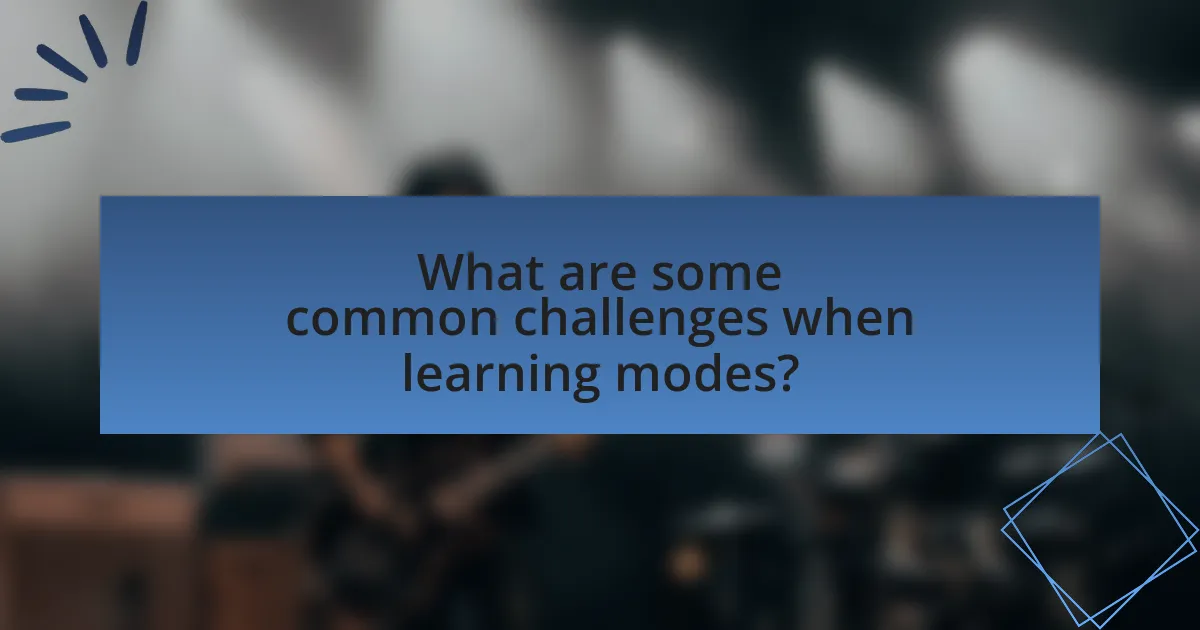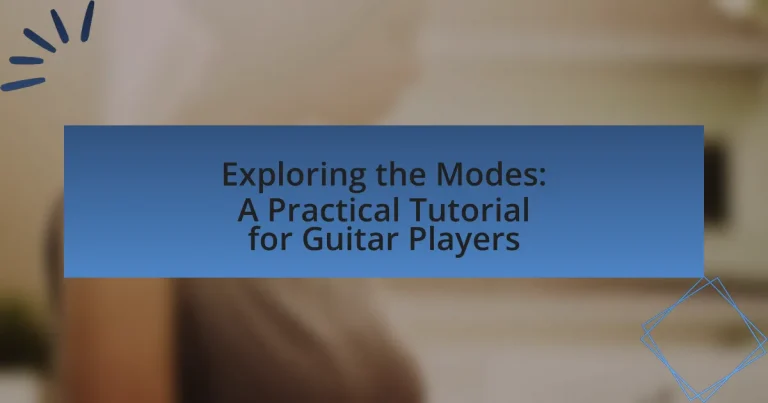The article “Exploring the Modes: A Practical Tutorial for Guitar Players” provides a comprehensive overview of musical modes derived from the major scale, including Ionian, Dorian, Phrygian, Lydian, Mixolydian, Aeolian, and Locrian. It explains the differences between modes and scales, detailing how each mode creates unique sounds and moods that can enhance composition and improvisation. The article emphasizes the importance of modes for guitar players, offering practical exercises, tips for effective learning, and ways to incorporate modes into various musical genres, particularly jazz, blues, rock, and metal. Additionally, it addresses common challenges and misconceptions related to learning modes, providing strategies to overcome these obstacles.

What are the Modes in Music Theory?
Modes in music theory are specific scales derived from the major scale, each with a unique sequence of intervals that create distinct tonalities. The seven modes are Ionian, Dorian, Phrygian, Lydian, Mixolydian, Aeolian, and Locrian, corresponding to the degrees of the major scale. For example, the Ionian mode is equivalent to the major scale, while the Dorian mode is the second degree of the major scale, characterized by a minor third and a major sixth. Each mode serves different musical purposes and evokes various emotions, making them essential for composition and improvisation.
How do modes differ from scales?
Modes differ from scales primarily in their structure and function within music theory. A scale is a sequence of notes in ascending or descending order, typically based on a specific pattern of intervals, such as the major or minor scale. In contrast, a mode is derived from a scale by starting on a different note within that scale, resulting in a unique sequence of intervals and tonal characteristics. For example, the C major scale consists of the notes C, D, E, F, G, A, and B, while the D Dorian mode, which is the second mode of the C major scale, starts on D and includes the notes D, E, F, G, A, B, and C. This shift in the starting note alters the tonal quality and emotional expression of the music, demonstrating how modes provide different flavors and applications compared to traditional scales.
What are the seven modes derived from the major scale?
The seven modes derived from the major scale are Ionian, Dorian, Phrygian, Lydian, Mixolydian, Aeolian, and Locrian. Each mode corresponds to a specific degree of the major scale, starting from the root note. For example, the Ionian mode is the first mode and is equivalent to the major scale itself, while the Dorian mode is the second mode, characterized by a minor sound with a raised sixth degree. This structure is consistent across all modes, with each offering a unique tonal quality based on the intervals between the notes.
How does each mode create a unique sound or mood?
Each musical mode creates a unique sound or mood through its specific interval structure and tonal characteristics. For example, the Ionian mode, which is equivalent to the major scale, evokes a bright and happy mood due to its whole and half-step pattern that emphasizes the tonic and major third intervals. In contrast, the Dorian mode, characterized by a minor third and a major sixth, produces a jazzy and somewhat melancholic sound, often used in blues and jazz music.
The Phrygian mode, with its flat second and minor intervals, conveys an exotic and mysterious atmosphere, frequently found in flamenco music. The Lydian mode, featuring a raised fourth, creates a dreamy and ethereal quality, making it popular in progressive rock. The Mixolydian mode, with its dominant seventh, generates a bluesy and relaxed vibe, commonly used in rock and funk genres. Lastly, the Aeolian mode, or natural minor scale, evokes a somber and introspective mood, often utilized in ballads and emotional pieces.
These distinct emotional qualities arise from the specific intervals and relationships between notes in each mode, influencing the listener’s perception and emotional response.
Why are modes important for guitar players?
Modes are important for guitar players because they provide a framework for improvisation and composition, allowing musicians to explore different tonalities and emotional expressions. Each mode corresponds to a specific scale derived from the major scale, offering unique intervals and characteristics that can enhance musical creativity. For instance, the Dorian mode is often used in jazz and blues for its minor quality with a raised sixth, while the Mixolydian mode is favored in rock for its dominant seventh sound. Understanding modes enables guitarists to expand their musical vocabulary, facilitating more sophisticated solos and chord progressions.
How can understanding modes enhance improvisation skills?
Understanding modes enhances improvisation skills by providing musicians with a framework for creating melodies and harmonies that evoke different emotions and atmospheres. Each mode has a unique tonal quality; for instance, the Dorian mode offers a jazzy, minor sound, while the Mixolydian mode presents a bright, major feel. By mastering these modes, guitar players can expand their improvisational vocabulary, allowing them to navigate chord progressions more creatively. Research indicates that musicians who utilize modes in their improvisation can achieve greater expressiveness and originality in their performances, as modes facilitate the exploration of diverse musical ideas and styles.
What role do modes play in songwriting and composition?
Modes play a crucial role in songwriting and composition by providing distinct tonal frameworks that influence melody, harmony, and emotional expression. Each mode, such as Dorian or Mixolydian, offers unique intervals and characteristics that can evoke specific feelings or atmospheres, allowing songwriters to create varied musical landscapes. For instance, the Dorian mode is often associated with a jazzy or soulful sound, while the Phrygian mode can convey a more exotic or mysterious vibe. This versatility enables composers to explore different musical ideas and themes, enhancing their creative palette.

How can guitar players effectively learn and apply modes?
Guitar players can effectively learn and apply modes by systematically practicing each mode in various keys and contexts. This involves understanding the theoretical framework of modes, such as the Ionian, Dorian, Phrygian, Lydian, Mixolydian, Aeolian, and Locrian, and how they relate to the major scale. Players should practice scales and arpeggios associated with each mode, using backing tracks to apply them musically. Additionally, analyzing songs that utilize specific modes can enhance understanding and application. Research indicates that active engagement with modes through improvisation and composition solidifies learning, as demonstrated in studies on music education that highlight the importance of practical application in skill acquisition.
What are practical exercises for mastering modes on the guitar?
Practical exercises for mastering modes on the guitar include playing scales in different modes, improvising over backing tracks, and applying modes to chord progressions. For instance, practicing the C major scale in various modes—Ionian, Dorian, Phrygian, etc.—helps internalize their unique sounds. Additionally, using backing tracks allows guitarists to experiment with improvisation in specific modes, reinforcing their understanding of how modes function melodically. Applying modes to common chord progressions, such as using Dorian over a minor chord progression, further solidifies the practical application of modes in musical contexts. These exercises are effective because they engage both technical skill and musicality, essential for mastering modes on the guitar.
How can scale patterns help in learning modes?
Scale patterns facilitate the understanding and application of modes by providing structured frameworks for improvisation and composition. These patterns allow guitar players to visualize and internalize the unique intervals and tonalities associated with each mode, enhancing their ability to navigate different musical contexts. For instance, using the C major scale as a foundation, players can derive the Dorian mode by starting on the second degree, which helps them recognize the specific sound and feel of that mode. This method of learning through scale patterns is supported by educational resources like “The Guitar Handbook” by Ralph Denyer, which emphasizes the importance of scale patterns in mastering modal playing.
What fingerings are most effective for each mode?
The most effective fingerings for each mode on the guitar are as follows:
- Ionian (Major) Mode: Use the standard major scale fingering, starting on the root note.
- Dorian Mode: Utilize the second degree of the major scale fingering, emphasizing the flat third and seventh.
- Phrygian Mode: Apply the minor scale fingering, focusing on the flat second and flat sixth.
- Lydian Mode: Implement the major scale fingering with a raised fourth, starting from the root.
- Mixolydian Mode: Use the major scale fingering, highlighting the flat seventh.
- Aeolian (Natural Minor) Mode: Apply the minor scale fingering, emphasizing the flat third, sixth, and seventh.
- Locrian Mode: Utilize the diminished scale fingering, focusing on the flat second, flat third, flat fifth, and flat seventh.
These fingerings correspond to the scale degrees and characteristic intervals of each mode, facilitating effective practice and application for guitar players.
How can modes be applied in different musical genres?
Modes can be applied in different musical genres by providing unique tonal frameworks that influence melody and harmony. For instance, the Dorian mode, characterized by a minor quality with a raised sixth, is prevalent in jazz and funk, allowing for improvisational freedom and complex chord progressions. In contrast, the Mixolydian mode, which features a major quality with a lowered seventh, is commonly found in rock and blues, contributing to a dominant sound that enhances the genre’s characteristic riffs. Additionally, the Phrygian mode, with its exotic minor sound, is often utilized in flamenco and metal, creating a distinct atmosphere that aligns with the emotional intensity of these styles. These applications demonstrate how modes serve as foundational elements that shape the identity and expression within various musical genres.
What modes are commonly used in jazz and blues?
The modes commonly used in jazz and blues include the Dorian, Mixolydian, and Aeolian modes. The Dorian mode, characterized by a minor third and a major sixth, is frequently employed in jazz improvisation, allowing for a blend of minor and major tonalities. The Mixolydian mode, with its dominant seventh sound, is essential in blues, providing a strong foundation for the genre’s characteristic chord progressions. The Aeolian mode, or natural minor scale, is also prevalent in both jazz and blues, offering a melancholic feel that complements the emotional depth of the music. These modes are integral to the harmonic and melodic structures that define jazz and blues, making them essential tools for guitar players in these genres.
How do rock and metal genres utilize modes for solos?
Rock and metal genres utilize modes for solos by employing various scales that create distinct emotional and tonal qualities. For instance, the Dorian mode is frequently used in rock to produce a jazzy, bluesy feel, while the Phrygian mode is often favored in metal for its exotic and dark sound. These modes allow guitarists to explore different melodic possibilities, enhancing the expressiveness of their solos. The use of modes is supported by the fact that many iconic solos, such as those by bands like Metallica and Led Zeppelin, prominently feature modal playing, showcasing the versatility and depth that modes bring to the music.

What are some common challenges when learning modes?
Common challenges when learning modes include difficulty in understanding their theoretical concepts, confusion over their application in improvisation, and the struggle to integrate modes into practical playing. Theoretical concepts can be complex, as modes are derived from scales and require knowledge of intervals and relationships between notes. Additionally, guitar players often find it challenging to apply modes effectively during improvisation, leading to a lack of confidence in their musical expression. Finally, integrating modes into existing playing styles can be difficult, as it requires practice and familiarity with different musical contexts.
Why do many guitar players struggle with modes?
Many guitar players struggle with modes due to a lack of understanding of their theoretical foundations and practical applications. Modes are derived from scales, and without a solid grasp of how these scales function within different musical contexts, players often find it challenging to apply modes effectively in their playing. Additionally, the complexity of memorizing the distinct sound and feel of each mode can overwhelm guitarists, leading to confusion and frustration. This struggle is compounded by the fact that modes require a different approach to improvisation and composition compared to traditional major and minor scales, which many players are more familiar with.
What misconceptions about modes should be addressed?
Misconceptions about modes that should be addressed include the belief that modes are merely scales or that they are only useful for advanced players. Modes are distinct musical frameworks derived from the major scale, each with its own unique tonal characteristics and emotional qualities. For example, the Dorian mode is often mistaken for a minor scale, but it contains a raised sixth degree, giving it a different sound and feel. Additionally, many beginners think that modes are too complex to incorporate into their playing, when in fact, they can enhance improvisation and composition at any skill level. Understanding modes can significantly expand a guitarist’s musical vocabulary and creativity.
How can players overcome mental blocks related to modes?
Players can overcome mental blocks related to modes by practicing consistent and focused exercises that reinforce their understanding and application of each mode. Engaging in targeted practice, such as playing scales in different modes over backing tracks, helps solidify their familiarity and comfort with the modes. Research indicates that deliberate practice enhances skill acquisition and reduces anxiety, which can contribute to overcoming mental barriers. Additionally, breaking down complex concepts into smaller, manageable parts allows players to build confidence gradually, making it easier to integrate modes into their playing.
What tips can help guitar players effectively use modes in their playing?
Guitar players can effectively use modes by practicing each mode in isolation to understand its unique sound and character. This focused practice allows players to internalize the distinct intervals and tonal qualities of each mode, such as the major sound of the Ionian mode or the darker feel of the Dorian mode. Additionally, applying modes over backing tracks that emphasize the corresponding tonal center helps reinforce their practical application. For instance, using a Dorian mode over a minor chord progression highlights its characteristic sound. Regularly incorporating modes into improvisation and composition further solidifies their understanding and versatility in music.
How can players incorporate modes into their practice routine?
Players can incorporate modes into their practice routine by systematically integrating each mode into their scale exercises and improvisation sessions. For instance, a player can dedicate specific practice time to each mode, such as Dorian or Mixolydian, by playing the corresponding scale in various positions on the guitar neck. This method allows players to familiarize themselves with the unique sound and characteristics of each mode. Additionally, players can apply modes to backing tracks or jam sessions, focusing on improvising melodies that highlight the modal tones. Research indicates that structured practice with modes enhances musical versatility and creativity, as evidenced by studies showing improved improvisational skills among musicians who regularly practice modal exercises.
What are some creative ways to experiment with modes in improvisation?
Experimenting with modes in improvisation can be achieved through various techniques such as modal interchange, using drones, and applying different rhythmic patterns. Modal interchange involves borrowing chords from parallel modes to create unexpected harmonic shifts, enhancing the improvisational landscape. Utilizing drones, where a sustained note or chord underpins the improvisation, allows musicians to explore modal melodies freely without harmonic constraints. Additionally, incorporating diverse rhythmic patterns can shift the focus from melody to groove, encouraging creative exploration within a modal framework. These methods are supported by the practices of renowned improvisers who often employ such techniques to expand their musical vocabulary and expressiveness.


